Chekigo Peak, a lesser-known gem in the Gaurishankar region of Nepal, beckons adventurous climbers seeking a rewarding challenge. Standing tall at 6,257 meters, this peak offers a unique opportunity to conquer technical routes and savor the stunning panoramic views of the Himalayan giants. With its first authorized expedition dating back to 2002, Chekigo Peak has maintained its allure as a less-traveled destination, attracting those who desire a immersive cultural exploration alongside their alpine adventure. The journey promises a captivating blend of natural wonders and personal accomplishment, making it a tempting prospect for seasoned high-altitude enthusiasts.
Key Points
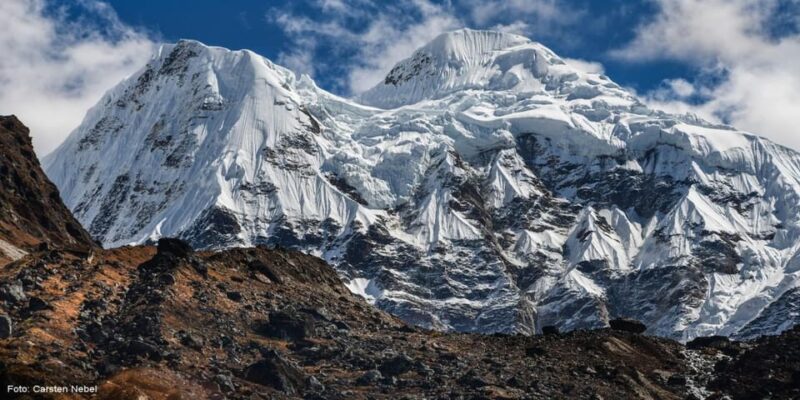
- Chekigo Peak is a 6,257-meter mountain located in the Gaurishankar peak region of the Khumbu Valley.
- The mountain offers diverse climbing routes and stunning views of major Himalayan ranges like Annapurna, Manaslu, and Langtang.
- Climbing Chekigo Peak requires technical expertise, including proficiency in rappelling, ascending, and navigating snowy terrain.
- The expedition typically lasts 9 days, starting with a drive from Kathmandu and trekking through Rhododendron forests to the base camp and high camp.
- Permits, specialized equipment, and comprehensive travel and medical insurance are essential for a successful and safe climb on Chekigo Peak.
Overview of the Expedition
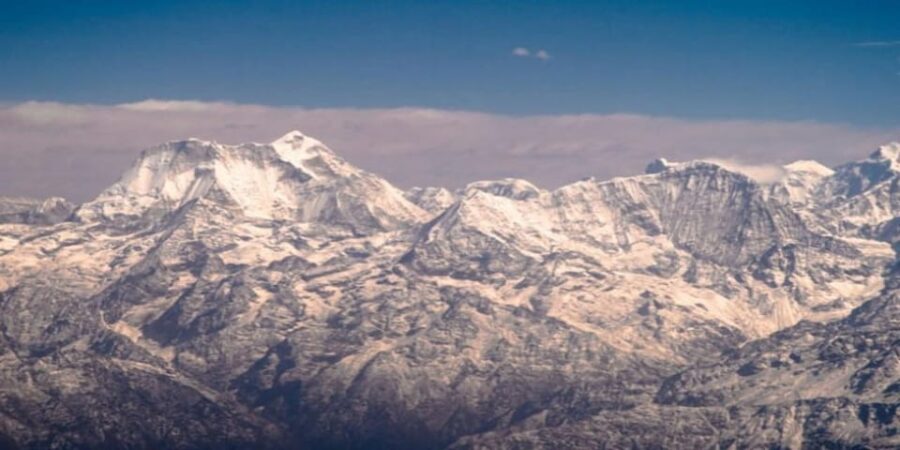
Chekigo Peak, an enticing 6257-meter summit, was first authorized for expedition in 2002.
Located in the Gaurishankar peak region of the Khumbu Valley near Mount Everest, this recently opened peak remains less frequented by climbers.
Offering diverse routes to the summit, Chekigo is set in the wilderness of the Rolwaling Valley.
While the peak’s remote location adds to its allure, it also requires crucial climbing apparatus and prior experience from aspiring adventurers.
Those willing to take on the challenge will be rewarded with stunning views of the Annapurna, Manaslu, Lamjung, Ganesh Himal, and Langtang mountain ranges.
You can also read our reviews of more tours and experiences in Jagat.
Highlights of the Climb
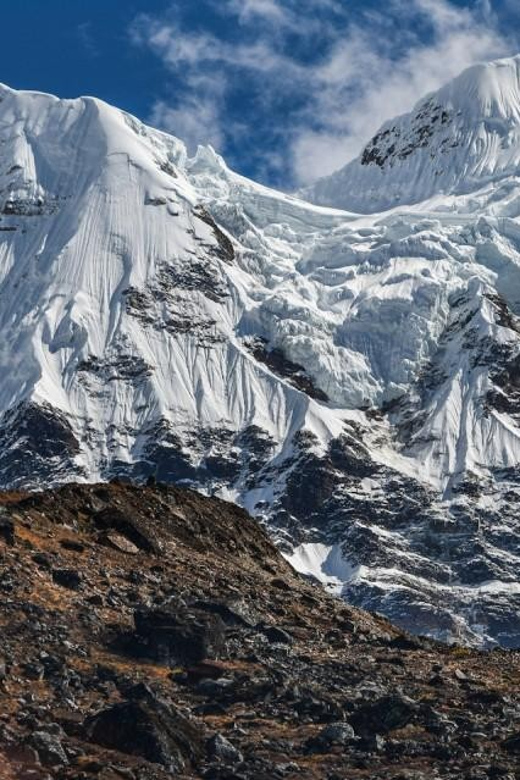
With a climbing duration of 9 days, the Chekigo Peak expedition offers a remarkable experience. Trekkers are rewarded with stunning vistas of the Annapurna, Manaslu, Lamjung, Ganesh Himal, and Langtang ranges. The diverse climbing routes through the Rolwaling Valley wilderness present thrilling challenges that require crucial climbing apparatus and prior experience. Along the way, adventurers may encounter Rhododendron forests, vibrant bird species, the historic Kalinchowk temple, and the sacred Biju Gompa. The climb’s highlights are summarized in the table below:
| Highlight | Description |
|---|---|
| Scenic Views | Panoramic vistas of towering Himalayan peaks |
| Ecological Diversity | Rhododendron forests, bird species, and alpine landscapes |
| Cultural Immersion | Interaction with local communities and sacred sites |
| Climbing Experience | Challenging routes demanding technical expertise |
Climbing Apparatus and Experience
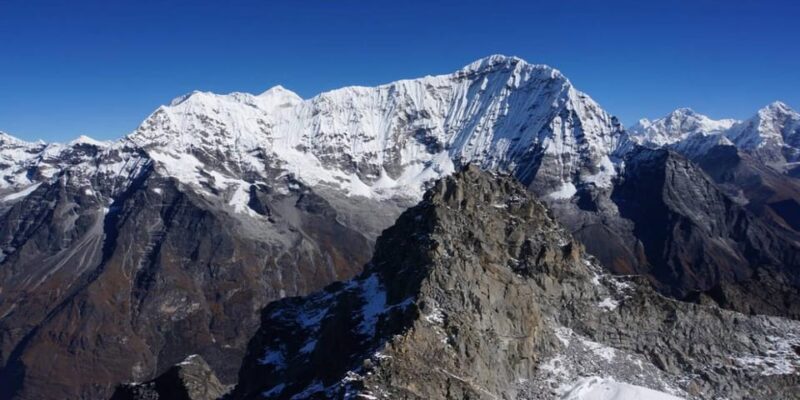
Technical climbing gear and prior experience form essential prerequisites for the Chekigo Peak expedition.
Climbers must be proficient in the use of ropes, harnesses, carabiners, ice axes, and crampons. Familiarity with techniques like rappelling, ascending, and navigating steep, snowy terrain is a must.
The routes to the summit offer diverse challenges, requiring mountaineering skills and fitness. Participants should have undertaken previous high-altitude climbs to acclimatize effectively.
The remoteness of the Rolwaling Valley adds to the adventure, but also demands self-reliance and proper preparation.
Climbers should be ready to face potential encounters with unpredictable weather, crevasses, and other mountain hazards on their quest to conquer Chekigo Peak.
Itinerary and Daily Schedules
The Chekigo Peak expedition follows a well-planned itinerary that takes adventurers through the stunning landscapes of the Rolwaling Valley.
The 9-day journey begins with a drive from Kathmandu to Chechet and a trek to Simi Gaon. Subsequent days see trekkers ascend to Beding, Chekigo Base Camp, and High Camp, before summiting the 6,121m peak.
The return leg involves descending to Beding, Simigaun, and back to Kathmandu.
Key highlights include:
- Panoramic views of Annapurna, Manaslu, Lamjung, Ganesh Himal, and Langtang.
- Opportunity to explore Rolwaling’s wilderness, including Rhododendron forests and the Kalinchowk temple.
- Support from a professional team of trekking guides, cooks, and porters.
Accommodations and Meal Arrangements
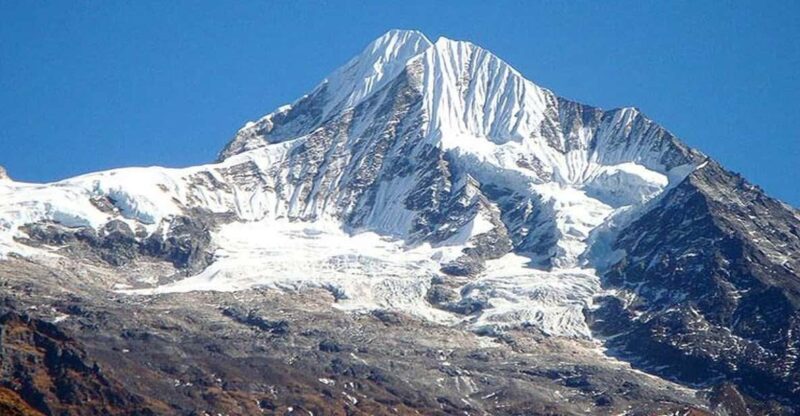
Throughout the Chekigo Peak expedition, participants enjoy comfortable accommodations and nourishing meals prepared by experienced staff. Trekkers stay in tents provided as part of the package, complete with mattresses for a good night’s rest.
Meals are served three times a day, cooked by a skilled expedition cook using fresh, local ingredients. The menu features a variety of Nepali and international dishes to satisfy diverse tastes.
Drinking water is provided, and special dietary requirements can be accommodated. This all-inclusive arrangement ensures climbers can focus on their summit attempt without worrying about basic necessities during the challenging journey.
Trekking Staff and Support
A team of experienced trekking staff and support personnel accompanies the Chekigo Peak expedition to ensure a safe and successful climb. This includes:
-
A professional, English-speaking trekking guide who leads the group, manages logistics, and provides on-site support.
-
A skilled cook who prepares nutritious, high-energy meals throughout the trek.
-
A team of porters who transport camping gear, food, and equipment, ensuring that climbers can focus on the ascent.
The staff’s expertise, along with the provision of necessary permits, rental gear, and domestic airfare, makes the Chekigo Peak adventure seamless and worry-free for participants.
Permits and Documentation
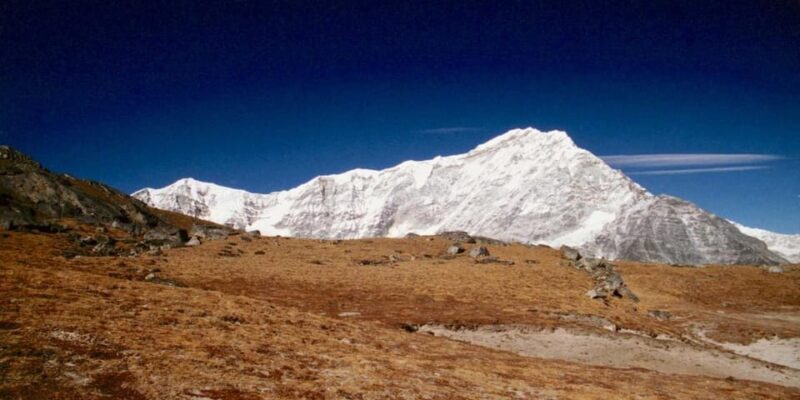
Securing the necessary permits and documentation is a critical aspect of the Chekigo Peak expedition. Climbers must obtain the Annapurna Conservation Area Permit (ACAP) and the Trekkers’ Information Management System (TIMS) card.
Plus, they’ll need the Chekigo Peak climbing permit and the Sherpa climbing guide fees. These permits ensure compliance with local regulations and provide access to the region.
The team will also require Nepal entry visas. Arranging these documents in advance is crucial, as the process can be time-consuming.
Failure to secure the proper paperwork could result in delays or even denial of access to the mountain. Diligent planning and attention to detail are essential for a successful Chekigo Peak climb.
Additional Expenses and Considerations
Along With the core costs of the Chekigo Peak expedition, travelers should budget for various other expenses and considerations.
These include:
-
Personal equipment: While some gear can be rented in Kathmandu, climbers may need to allocate around $170 for the rental of essential items such as sleeping bags, down jackets, and waterproof clothing.
-
Insurance and evacuation: Comprehensive travel and medical insurance is crucial, as is coverage for emergency evacuation in case of illness or injury during the climb.
-
Tips for support staff: It’s customary to provide gratuities to the guides, porters, and cooks who contribute to the success of the expedition.
Frequently Asked Questions
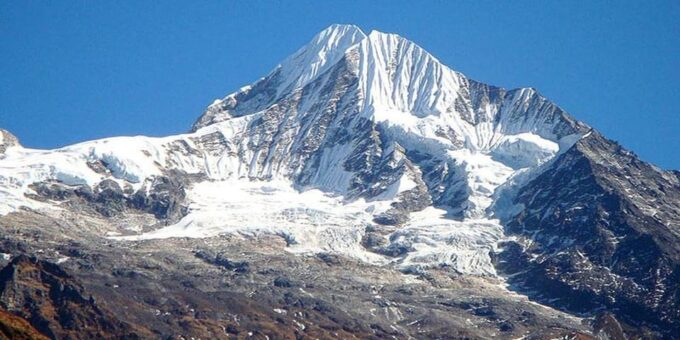
What Is the Success Rate for Summiting Chekigo Peak?
The success rate for summiting Chekigo Peak is not widely reported, as it’s a relatively new and less-frequented climbing destination. However, experienced mountaineers with proper equipment and preparation have a reasonable chance of reaching the summit under favorable weather conditions.
Can I Extend the Trek to Visit Nearby Cultural Sites?
Absolutely, the Chekigo Peak trek can be extended to visit nearby cultural sites such as the Kalinchowk temple and the Biju Gompa. This allows trekkers to enjoy the local culture and traditions during the expedition.
How Challenging Is the Climbing Route Compared to Other Peaks in the Region?
The climbing route to Chekigo Peak is more technical and challenging compared to other peaks in the region, requiring significant climbing experience and use of specialized equipment. While less frequented, the summit offers stunning views of the surrounding Himalayan giants.
Is There a Possibility of Encountering Wildlife During the Trek?
The trekker may encounter diverse wildlife during the journey, including Rhododendron forests and bird species. However, encounters with larger animals like Himalayan bears or snow leopards are less likely due to the remote and rugged terrain.
Can I Arrange a Private Expedition for My Group?
Yes, private expeditions can be arranged for groups. The tour operator offers customized itineraries and support staff to accommodate private trekking or climbing groups, allowing for more flexibility and a personalized experience.
The Sum Up
Chekigo Peak offers a challenging yet rewarding climbing experience for adventurous mountaineers. Its stunning panoramic views, diverse landscapes, and cultural exploration make this expedition a memorable one. However, it requires technical expertise and prior high-altitude experience, as well as the support of a professional trekking team. Climbers can expect an adventure filled with diverse environments and the chance to conquer a less-traveled Himalayan peak.
You can check if your dates are available here:More Tour Reviews in Jagat
Not for you? Here's more things to do in Jagat we have recnetly reviewed
- 8 Best Hiking And Trekking Tours In Jagat
- Manaslu Circuit Trek
- Manaslu Circuit Trek From Kathmandu
- Manaslu Tsum Valley Trek
- Tsum Valley Trek: Exploring the Hidden Gem
- Tsum Valley Trek (A Hidden Valley)
- Tsum Valley Trek : a Journey Into the Hidden Valley
- Mt.Larkya Peak Climbing
- From Kathmandu : Budget 15 Days Manaslu Circuit Trek
- From Kathmandu: 15-Day Manaslu Circuit Trek
- From Kathmandu: Manaslu Circuit Tea House Trek 11 Days
- From Kathmandu: Manaslu Circuit Trek 12 Day
